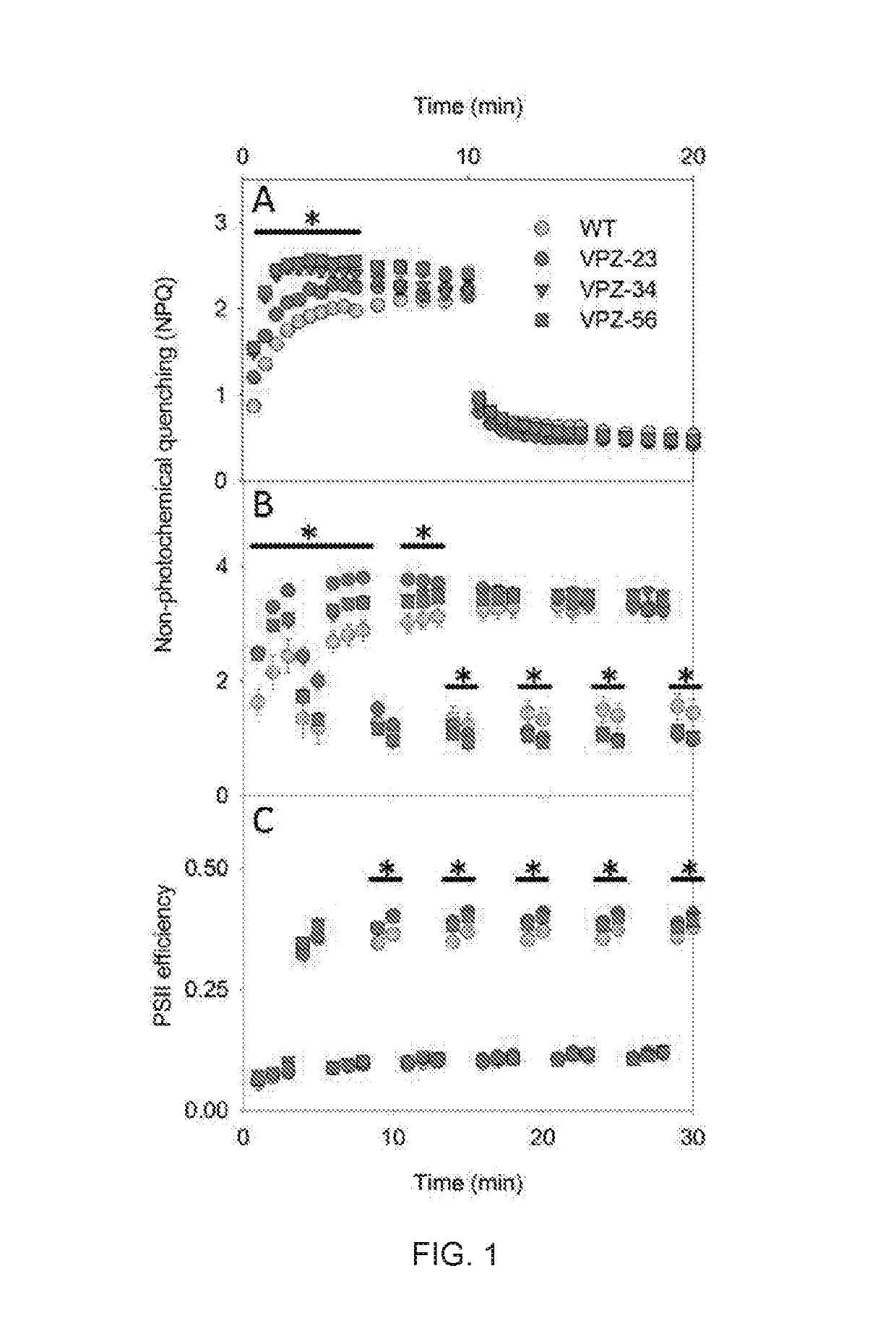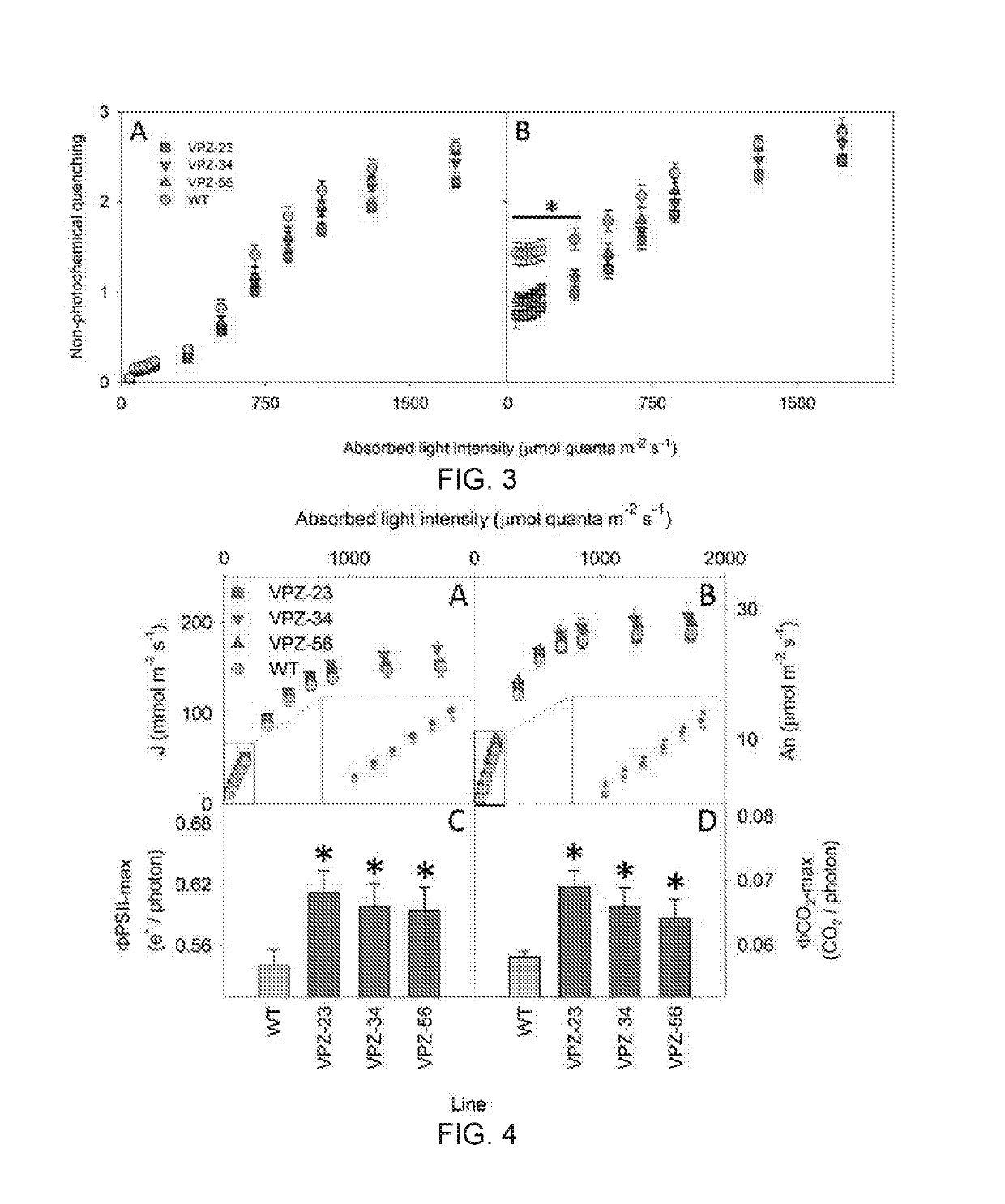Transgenic plants with increased photosynthesis efficiency and growth
a technology of photosynthesis efficiency and growth, applied in biochemistry, peptide sources, enzymology, etc., can solve the problems of limited transient proof, limited photosynthetic quantum yield and associated cosub>2 /sub>fixation, and relative slow rate of recovery of psii antennae, etc., to improve photoprotection efficiency, increase growth, and increase photosynthesis efficiency
- Summary
- Abstract
- Description
- Claims
- Application Information
AI Technical Summary
Benefits of technology
Problems solved by technology
Method used
Image
Examples
example 2
SII Operating Efficiency in Young Seedlings
[0201]Transient NPQ was determined from chlorophyll fluorescence imaging on T1 progeny of 20 independent transformation events with the vde-psbs-zep (VPZ) construct during 10 minutes of illumination with 1000 μmol quanta m−2 s−1, followed by 10 minutes of dark relaxation. Since the aim was to maintain similar non-photochemical quenching capacity, lines with maximum levels of NPQ similar to WT were selected for further investigation. This yielded eight lines from which two lines harboring a single T-DNA copy (VPZ-34 and 56) and one line with two T-DNA insertions (VPZ-23) were included in the present work. All results are reported for homozygous T2 progeny. NPQ kinetic behavior showed substantial differences between the three VPZ lines and WT (FIG. 1A). NPQ in the VPZ lines rapidly increased, reaching the maximum NPQ level between two to four minutes, after which the level of NPQ stabilized (VPZ-23) or even slightly decreased (VPZ-34 and VPZ-...
example 3
tion and Protein Expression
[0204]All three VPZ-lines showed significant increases in combined transgenic (At) and native (Nt) transcript levels of VDE (3-fold), PsbS (3-fold) and ZEP (8-fold) relative to wild-type (FIGS. 2A, B and C). For PsbS the increase in transcript levels translated into approximately 2-fold higher PsbS protein level (FIG. 2E), as exemplified in two approximately equal density bands around 22 kDa (FIG. 2G, VPZ lanes), representing the native and transgenic protein. However, for VDE and ZEP the increase in transcript levels was amplified in the protein levels (FIG. 2G, labelled bands around 73 kDa for ZEP and 45 kDa for VDE), showing substantial increases of VDE (FIG. 2D) and ZEP (FIG. 2F) protein relative to WT (16 and 80-fold, respectively). Interaction between transgenic and native transcript and protein levels appeared to be negligible, since transcript and protein levels of the native proteins were similar in the VPZ lines and WT.
example 4
of NPQ in Young Seedlings Following Repeated Changes in Light Intensity
[0205]To compare the kinetics of dynamic NPQ adjustment, time constants of a double exponential model were fitted to time-series of NPQ in young seedlings as a function of repeated changes in light intensity between 2000 and 200 μmol m−2 s−1 (Table 1). During the first 2000 / 200 cycle no consistent differences between WT and VPZ overexpression lines were observed. The time constant of NPQ induction varied between 49.3±1.9 (VPZ-34) to 91.8±6.2 (VPZ-56), and time constants of readjustment from 2000 to 200 μmol m−2 s−1 were also similar across WT and the three VPZ lines, averaging 10.2 s for τ1 and 669.9 s for τ2. During the second 2000 / 200 cycle, the effect of VPZ expression on NPQ kinetics became more apparent. The fast phase of NPQ increase in the WT was approximately 2.3 times faster than in the VPZ lines, with τ1 of 5.5 s in WT versus average τ1 of 12.6 s in the VPZ lines (Table 1). The second adjustment of NPQ ...
PUM
| Property | Measurement | Unit |
|---|---|---|
| time constants | aaaaa | aaaaa |
| time constants | aaaaa | aaaaa |
| dry weight | aaaaa | aaaaa |
Abstract
Description
Claims
Application Information
 Login to View More
Login to View More - R&D
- Intellectual Property
- Life Sciences
- Materials
- Tech Scout
- Unparalleled Data Quality
- Higher Quality Content
- 60% Fewer Hallucinations
Browse by: Latest US Patents, China's latest patents, Technical Efficacy Thesaurus, Application Domain, Technology Topic, Popular Technical Reports.
© 2025 PatSnap. All rights reserved.Legal|Privacy policy|Modern Slavery Act Transparency Statement|Sitemap|About US| Contact US: help@patsnap.com



